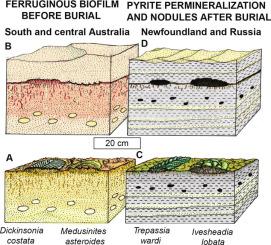Gondwana Research ( IF 7.2 ) Pub Date : 2022-06-18 , DOI: 10.1016/j.gr.2022.06.007 G.J. Retallack

|
Ferruginous biofilms are a form of preservation of fossil leaves making detailed imprints of venation even in coarse sandstone. In modern examples, the biofilm is robust enough to persist after separation, or rotting of the leaf. The biofilms are created by filamentous, iron-oxidizing bacteria such as Leptothrix and Sphaerotilus, and have distinctive felted microscopic textures. Ediacaran vendobionts with fine detail preserved in coarse sandstone show these diagnostic felted textures under the scanning electron microscope. These biofilms were thus pre-depositional ferruginous death masks, and lack distinctive framboidal textures or pyritohedral textures of pyrite. Pyritic external-only “death masks” are undocumented from any geological age or locality. Ediacaran fossils are also preserved by silica permineralization, silica-cemented molds and casts, and pyrite permineralization and replacement after burial. This examination of unskeletonized Ediacaran fossils from Australia, Russia, Namibia, California, and Newfoundland in thin section and scanning electon microscope shows no evidence for a uniquely Ediacaran style of fossil preservation.
中文翻译:

埃迪卡拉纪化石的铁质生物膜保存
含铁生物膜是化石叶子的一种保存形式,即使在粗砂岩中也能留下详细的脉络印记。在现代例子中,生物膜足够坚固,可以在叶子分离或腐烂后持续存在。生物膜是由丝状铁氧化细菌(如细丝菌属和球孢属)产生的,并具有独特的毡状微观纹理。保存在粗砂岩中的具有精细细节的埃迪卡拉纪生物在扫描电子显微镜下显示出这些诊断性的毡状纹理。因此,这些生物膜是沉积前的铁质死亡面具,并且缺乏黄铁矿的独特的棱柱状纹理或梨四面体纹理。任何地质时代或地区都没有记录在案的仅外部硫铁矿“死亡面具”。埃迪卡拉纪化石还通过二氧化硅全矿化、二氧化硅胶结模具和铸件以及黄铁矿全矿化和埋葬后的置换而得以保存。这项对来自澳大利亚、俄罗斯、纳米比亚、加利福尼亚和纽芬兰的无骨骼埃迪卡拉纪化石的薄切片和扫描电子显微镜检查显示没有证据表明化石保存具有独特的埃迪卡拉纪风格。











































 京公网安备 11010802027423号
京公网安备 11010802027423号